This is an important question, especially if you have fair skin and have tanned or sunburned. Skin cancer is the number one cancer in humans, far exceeding the total of all other cancers. With a diminishing ozone, one in six Americans will get skin cancer in his or her lifetime.
"Doctor, I haven't been in the sun for 30 years." The fact is, skin cancer may not appear until 10, 20, 30, or 40 years after a sunburn. how can you tell if you have skin cancer? Skin cancer usually begins as a small non-healing spot on the skin. The spot does not hurt, but may itch or bleed. Many do not see a doctor until pain or bleeding occurs, or until the spot has grown into a larger tumor. A simple way to understand skin cancer is to categorize it as either:
- Non-melanoma skin cancer or
- Melanoma skin cancer
|
| |
| |
|
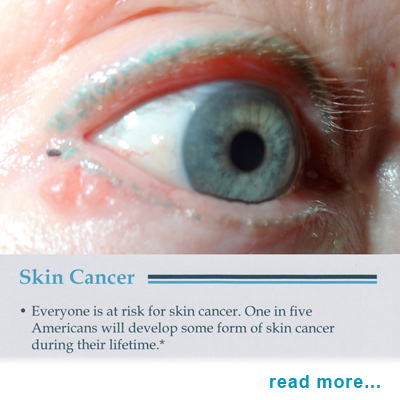
|
| |
|
AK: Actinic Keratoses are precancerous scales that grow on sub damaged skin. If left untreated, AK's can become more aggresive BCC or SCC skin cancers.
|
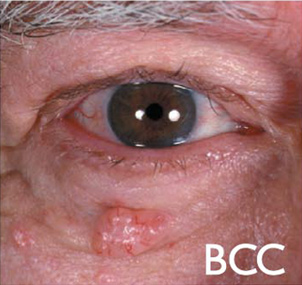 |
| |
|
| BCC is a low-grade cancer that can cause severe facial disfigurement or loss of an eye, nose, or ear if not treated. |
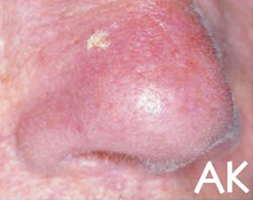 |
| |
|
| SCC is a skin cancer that can spread to your lymph nodes if not treated. A simple ounce of prevention is worth a pound of cure. |
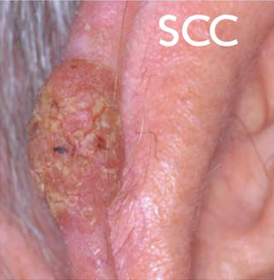 |

Are you at risk for skin cancer? Should you be concered? Finding out is easy to do. Here are six easy questions to ask and see if you are at risk for skin cancer.
- Do you have a persistent non-healing sore on your skin?
- Do any of your relatives have a history of skin cancer?
- Have any of your moles changed in color, shape, size?
- Are you eyes blue, green, hazel?
- I your skin fair or light in color?
- Have you ever been sunburned?
If you answered "yes" to any, you are at risk and must get checked!

|
|
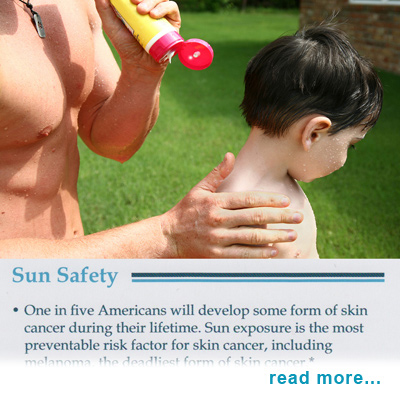
|
| |
|
The American Academy of Dermatology does not recommend getting vitamin D from sun exposure or indoor tanning because ultraviolet rays from the sun and tanning beds can cause skin cancer.
...click the pop-up to the right to learn more. |
|
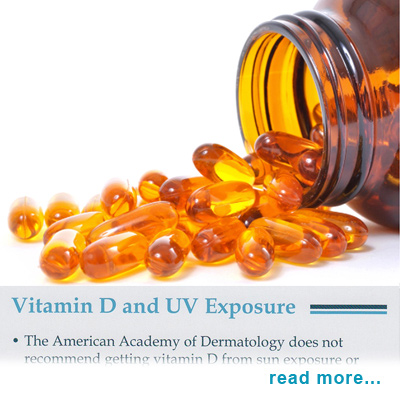
|
| |
|

|
Common Moles
Most people have a number of small colored spots on their bodies-moles, freckles, and birthmarks. The average young adult has at least twenty-five brown moles. A few of these spots are present at birth, while most others develop throughout life. Most moles are normal and will remain normal for life. However, a change in a mole or other spot on the skin may be the first sign of any early malignant melanoma or other form of skin cancer. |
| |
Malignant Melanoma
Malignant melanoma is a serious skin cancer that arises in moles or in the tanning cells of the skin. In its early stages, when it can be easily treated, the disease is not life threatening. But in later stages, malignant melanoma spreads or metastasizes to other parts of the body. At this point, treatment is not always successful. People at high risk of developing melanoma are those who have: |
|

|
| |
- A family history of melanoma, or who have had a melanoma in the past.
- Unusual moles on the skin, or changing moles.
- Fair skin, light hair and eye color, who sunburn easy or tan with difficulty.
- A record of painful or blistering sunburns as children or teenagers.
- Indoor occupations and outdoor recreational habits.
The ABCD's of Moles & Melanomas
Regular self-examination is the best way to become familiar with many moles and spots on the skin, including hard-to-see areas (mouth, back, scalp, buttocks, etc.). Common moles and malignant melanomas may or may not look alike. You should inspect your moles and pay special attention to their sizes, shapes, edges, and colors. A way to remember important suspicious features is to think of A-B-C and D for Asymmetry, Border, Color, and Diameter. Is it a melanoma? Ask A,B,C,D.
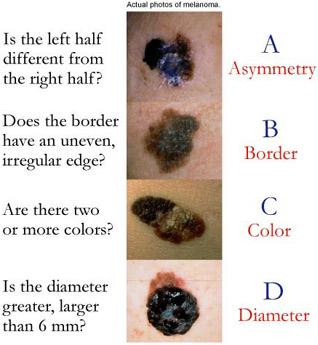

1. Is there a family history of melanoma?
2. Do family members have many moles?
3. Is there a history of a sunburned mole?
4. Are there symptoms? Is the mole:
 Growing? Growing?  Changing in Color? Changing in Color?  Bleeding? Bleeding?  Itching? Itching?  Scaling? Scaling?
Two ABCD's positive out of five may be a sign that your mole needs a biopsy.

Here are my 10 helpful tips for sun protection:
- Avoid the midday sun as much as possible.
- Wear a hat and protective clothing.
- Apply sunscreen frequently.
- Wear sunglasses that block UV radiation.
- Beware of photosensitive medications.
- Beware of sunscreen allergies. Use a PABA free sunscreen.
- Beware of reflective surfaces like water and snow.
- Avoid tanning parlors.
- Teach your children sun protection at an early age.
- Watch for the National Weather Service UV Index.
|








